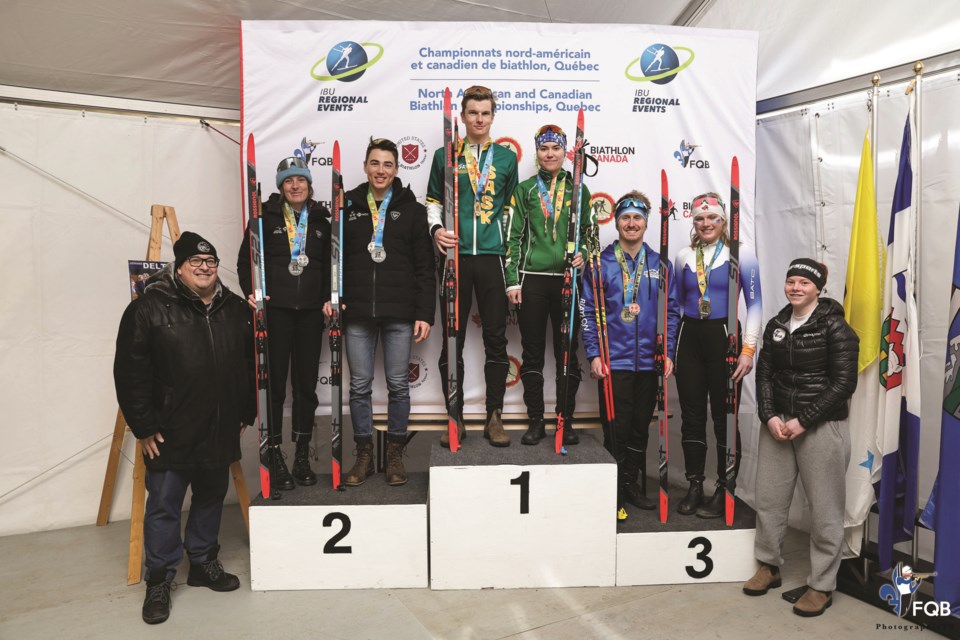Most Whistlerites understand skiing. Some prefer the adrenaline rush found in the backcountry, while others forgo the verticality of Whistler Blackcomb for the expansive trails criss-crossing Callaghan Valley.
Now add to that a lightweight, .22-calibre rifle designed for accuracy in cold conditions. Then try skiing a few kilometres, stopping, pulling that rifle off your shoulder and hitting targets from 50 metres out. That’s biathlon.
The idea of skiers wielding rifles goes back to 18th-century Scandinavian soldiers patrolling their borders, although the Winter Olympics did not pick up biathlon as a sport until 1960. Myriam Bédard of Quebec is the only Canadian to win an Olympic medal in the discipline, earning two golds and a bronze in 1992 and 1994.
From March 13 to 19, a bevy of Whistlerites carried on the tradition at the IBU North American and Canadian Championships in Valcartier, Que. Four seniors returned home with hardware: Hanne Stadnyk, Lucas Smith, Graham Benson and Mia Rodger.
Valcartier highlights
Stadnyk won two bronze medals in the Senior Women’s sprint and mass start events to go with silver in the single mixed relay alongside Lucas Smith, her fellow Whistler Nordic Development Centre (WNDC) athlete.
Smith earned an individual silver in the mass start as the race’s top Canadian and narrowly missed out on the senior men’s pursuit podium in fourth.
Meanwhile, Benson locked up two medals in contention against senior boys: mass start silver and pursuit bronze.
Rodger, who could not be reached for comment by press time, was the most decorated of them all, winning double gold in the senior girls pursuit and sprint. She also teamed up with Benson for a respectable fifth-place finish in the single mixed relay.
A few Whistler youths reached the podium as well. Dan Gilfillan took home silver in sprint and pursuit in the youth men category, in addition to combining with Moira Green for mixed relay gold.
All are grateful for the opportunity to represent the Maple Leaf on home soil.
“I think it’s a really nice way to wrap up the whole season and come together with everyone across the country. You get to see everyone again, have some fun races, and a lot of the pressure kind of comes off you,” said Stadnyk, who is originally from Saskatchewan.
Benson admitted to being a little anxious going in. At 16 years old, he is among the oldest in his age category and raced against more than 40 opponents at his second trip to Nationals. Ultimately, he overcame those pre-race jitters.
“I was able just to start thinking about the process a little more, and not worry about the outcome so much, and that really helped me lock in and put down some good racing,” he explained.
Smith is the most experienced of the bunch, having spent time in Europe on the International Biathlon Union (IBU) Cup circuit. He knew that many eyes were on him and his peers as the older, more accomplished contenders in Quebec. Although the Winnipeg, Man. native is used to facing rivals from abroad, he knew he still had to be on point at the event, which also serves as the North American Championships.
“It’s not really a walk in the park,” Smith said. “Approaching Nationals for me was about making sure that I was staying sharp and undergoing the same processes domestically as I would internationally.”
Practice and fortitude
All the athletes experienced highs and lows over the course of their Valcartier experience. Stadnyk ground through fatigue to reach the women’s mass start podium, while issues hitting his targets relegated Benson to tenth in the sprint.
Smith stumbled in the sprint as well, ending up seventh in what was not his finest outing. Rodger incurred a two-minute penalty in her mass start, which was enough to bump her down to sixth.
Yet, they managed to regroup. Benson and Smith, in particular, draw energy from head-to-head races such as the mass start and pursuit, so it’s no surprise they performed better in those events. Then there are relays, which add another dimension to any skier’s gameplan.
“You kind of start to reason things through with yourself [in an individual event], validating why you’re making certain decisions, but when you’re on a team with someone else, you don’t have that [luxury],” explained Stadnyk.
Smith agrees wholeheartedly. “When you’re in a relay, it kind of feels like your whole identity just falls to the wayside,” he said. “It’s about the team, and who is going to come after you and what they want. That gives you a sense of strength, because you’re fighting for something that you [and your team] collectively believe in.”
Benson was born in Vancouver and took up biathlon at eight years old—earlier than normal because coaches were impressed with his older brother. Stadnyk tried it out as a teen after her own brother was recruited by a provincial coach, and she is still going strong at age 25.
Meanwhile, Smith’s cross-country skiing background laid an excellent foundation for his present as a biathlete. At 10 years old, he thought shooting a gun was “the coolest thing in the world” and he still feels that way 13 years later.
“For the average person, it probably seems crazy what we do, going from 180 or 190 beats per minute down to about 140, which is a nice calming heart rate for us to shoot at. And to do that in the span of 10 seconds,” said Smith.
“But it just comes down to breathing practice and mental fortitude.”
Full results from Valcartier are available at biathloncanada.ca.




